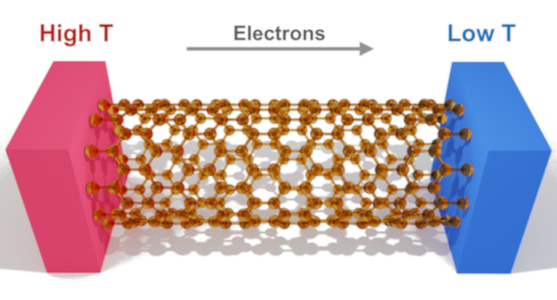Thermoelectricity

Keywords: Seebeck effect, Electrical conductivity, Thermal conductivity, Carrier mobility, Low‐dimensional materials
Thermoelectricity is the direct conversion of heat into electricity (or vice versa) through phenomena like the Seebeck, Peltier, and Thomson effects, enabling applications in temperature measurement, energy harvesting, and cooling.
Thermoelectric materials design
The performance of a thermoelectric material is characterized by the “Power Factor” (PF) or “Figure of Merit” (ZT), which takes into account the Seebeck coefficient, electrical conductivity, and thermal conductivity. A higher PF indicates a material that can generate more power for a given temperature difference, while high ZT indicates that the material can convert heat to electricity more efficiently. Researchers focus on developing materials with both high PF and high ZT. A significant progress have started for thermoelectricity of low‐dimensional materials since 1993 when Hicks and Dresselhaus presented the theory of confinement effect. The theory of confinement has inspired experimental works on the use of low‐dimensional materials for improving thermoelectric efficiency for more than two decades. However, many people have tried that experimentally, and no one has been quite successful. In 2016, we introduced a new general concept, the so-called “quantum confinement effect”, which has elucidated a mechanism to improve the thermoelectric power factor for any low-dimensional materials. Many experimental groups adopted our theory to explain the quantum confinement phenomena in their experiments.
In this topic, we aim to design the thermoelectric material with a ZT up to 10. In this case, the thermoelectric material can have an energy conversion efficiency of 30% at room temperature and can compete with existing energy technologies, such as internal combustion engines or solar cells.
Selected Publications
- N. T. Hung, A. R. T. Nugraha and R. Saito, Designing high-performance thermoelectrics in two-dimensional tetradymites, Nano Energy 58, 743-749 (2019).
- N. T. Hung, A. R. T. Nugraha and R. Saito, Universal curve of optimum thermoelectric figure of merit for bulk and low-dimensional semiconductors, Phys. Rev. Appl. 9, 024019 (2018).
- N. T. Hung, A. R. T. Nugraha and R. Saito, Two-dimensional InSe as a potentialthermoelectric material, Appl. Phys. Lett. 111, 092107 (2017).
- N. T. Hung, E. H. Hasdeo, A. R. T. Nugraha, M. S. Dresselhaus and R. Saito, Quantum effects in the thermoelectric power factor of low-dimensional semiconductors, Phys. Rev. Lett. 117, 036602 (2016).
- N. T. Hung, A. R. T. Nugraha, E. H. Hasdeo, M. S. Dresselhaus and R. Saito, Diameter dependence of thermopower of semiconducting carbon nanotubes, Phys. Rev. B 92, 165426 (2015).